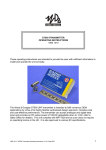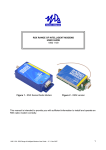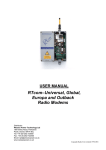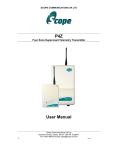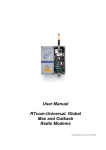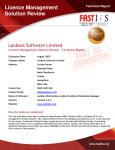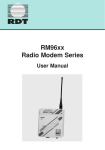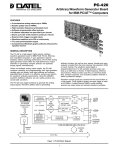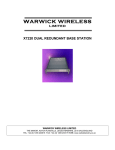Download Wood and Douglas 1892 Operating instructions
Transcript
SR500 RECEIVER OPERATING INSTRUCTIONS 1892 1211 These operating instructions are intended to provide the user with sufficient information to install and operate the unit correctly. The Wood & Douglas SR500 UHF synthesized receiver is intended to fulfil numerous OEM applications by virtue of its highly flexible synthesized design approach, miniature size and cost-effective performance. The unit complies with MPT1329 and as such does not require an operating licence in the UK. It is also approved to various EC specifications. 1892 1211 - SR500 Receiver Operating Instructions - 2.10 / May 2006 1 DIMENSIONS AND FIXING The unit is intended for PCB mounting within the customer’s equipment. Figure 1 - SR unit dimensions and connectors 2 1892 1211 - SR500 Receiver Operating Instructions - 2.10 / May 2006 CONNECTION Connection to the unit is via PL1, PL2 and PL3 which plug directly into the user's own equipment. The location of these connectors is shown in Figure 1 and detailed in the following tables. PIN NAME 1 0V 2 FUNCTION 0 volts RF I/P RF input 3 0V 0 volts REMARKS common ground 50O input common ground Connector PL1 pin detail PIN NAME 1 +VIN 2 0V FUNCTION REMARKS positive supply +6.0V to +14.0V 0 volts common ground Connector PL2 pin detail PIN NAME FUNCTION REMARKS 1 RSSI S meter output 0.5 - 2V signal strength indicator, 60dB range 2 SQF Squelch flag open collector output, ON (low) = no signal (15V max) 250mV p-p +20% into 10kO Note: The output audio is inverted with respect to the ST500 (or similar Wood & Douglas product) audio input. 3 AUDIO AF output 4 DATA Data output open collector, no pull-up (14V max) Note: The data output is inverted with respect to the ST500 (or similar Wood & Douglas product) data input. 5 +5V +5 volt supply output 50mA maximum permissible current drain 6 0V 0 volts common ground 7 RS232 I/P serial programming input 8 RB1 9 RB2 10 RB3 parallel frequency select RS232 programming input Note: inverted TTL level data can also be used. If not used, leave not connected, or connect to 0V internal pull-up to +5V, active low low < 0.8V high > 4.0V Connector PL3 pin detail 1892 1211 - SR500 Receiver Operating Instructions - 2.10 / May 2006 3 OPERATING FREQUENCIES Each radio is made to order to cover a band (the switching bandwidth) of 5MHz within the range 400 - 470 MHz. Each radio is also manufactured to work within a particular channel width of 12.5kHz, 20kHz or 25kHz. Within the switching bandwidth, the unit can operate on any frequency provided it is a multiple of the channel width, and up to 128 frequencies can be stored as numbered channels. Before the unit leaves the factory, each of the 128 channels is allocated to a frequency, but you can reprogram them if you wish. The first 16 channels can be individually programmed, and the remaining 112 are sequentially programmed by entering a starting frequency and a step size. The programming is done using Wood & Douglas software (STSRn00.exe) which runs on a PC under Windows. The PC and the unit communicate via an asynchronous RS232 serial link. In order to reprogram the unit, an adaptor must be used to connect the unit to the serial port of the PC and a power supply. This also inverts the readback output of the unit and converts from TTL to RS232 levels for the PC. See the Appendix on page 13 for a suitable adaptor. OBTAINING AND RUNNING THE PROGRAMMING SOFTWARE 1. Download the latest version of the programming software from the Wood & Douglas site on the internet. The URL (address) is: http://www.woodanddouglas.co.uk/products/software/stsrn00.exe In case of difficulty, contact Sales at Wood & Douglas. v Note that you must have software version 1.00.21 or greater to program units labelled “13MHz TCXO” 2. Connect the unit to a suitable supply and to the PC using the programming adaptor (see page 13). 3. Run the STSRn00.exe program. It will run in a full-screen character session. v Please note that mouse operation is not supported with this program. 4. You are prompted to enter the serial port number of the PC which is used to communicate with the unit. Type 1 or 2 and press the <enter> key. 5. In the same way, follow the prompt to select transmitter or receiver: 1: STn00 2: SRn00 6. Finally, select the frequency range: 1 : ST/SR100 (125 - 180MHz) 2 : ST/SR500 (400 - 500MHz) 3 : ST/SR800 (860 - 880MHz) At this stage, the main menu screen is displayed as shown in Figure 2. The screen shows the default settings which are displayed whenever the STSRn00 software is run. 4 1892 1211 - SR500 Receiver Operating Instructions - 2.10 / May 2006 STSRn00 Programmer v.1.0.21 Chan Chan Chan Chan Chan Chan Chan Chan Chan Chan Chan Chan Chan Chan Chan Chan 0 1 2 3 4 5 6 7 8 9 10 11 12 13 14 15 458.5 458.5125 458.525 458.5375 458.55 458.5625 458.575 458.5875 458.6 458.6125 458.625 458.6375 458.65 458.6625 458.675 458.6875 Start table 458.7 Max. Freq. 458.95 Table step 1 x 12.5 MHz << MHz MHz MHz MHz MHz MHz MHz MHz MHz MHz MHz MHZ MHz MHz MHz MHz MHz kHz Comparison freq. 12.5 kHz Ref. (TCXO) freq. 12.8 MHz Parallel channel select COMMANDS: F2 :copy Ch 16-31 to Ch 0-15 F3 :change comparison frequency F4 :set parallel ch. mode F5 :read from unit F6 :program unit F7 :program serial channel F12:QUIT Sequential frequencies, Chan. 16 to 127 Figure 2 - Programming screen Note: Comparison and Ref (TCXO) frequencies are display-only, and cannot be programmed by the user. 1892 1211 - SR500 Receiver Operating Instructions - 2.10 / May 2006 5 PROGRAMMING THE UNIT Three steps are necessary: v v v Upload values from the unit Edit the values Download values to the unit Uploading Current Unit Settings (F5) First, you must read into the computer what is in the unit’s memory at present. To do this, press F5. The data replaces the default on the screen. v The program insists that you do this before allowing you to reprogram the unit to make it less likely that inappropriate values be entered. v However, once you have uploaded during a session, you may edit and download the data to as many units as you wish. Caution: If you do this, you must ensure that the units are all of the same type. Check that all units are of the 13MHz TCXO type (“13MHz TCXO” label affixed opposite serial number label) or the 12.8MHz TCXO type (no such label). If you change unit type, you must use F5 again. Programming Individual Channels (0-15) To set the frequency of one of the first 16 channels (0-15), which can be individually set, use the arrow keys to move the highlight over that channel and type in a frequency in MHz. v The entered value must be an integer multiple of the Comparison Frequency shown at the top right of the screen, otherwise an ‘invalid’ message is displayed. v Make sure that the value is within the switching bandwidth of your unit, as the software cannot prevent you from inserting an inappropriate value. Press the <enter> key to complete. Programming Sequential (Table or Block) Channels (16-127) To set the frequency of channels 16-127, which can only be allocated as a block, use the arrows to highlight Start Table and type in the lowest frequency (channel 16). v 6 The entered value must be an integer multiple of the Comparison Frequency shown at the top right of the screen, otherwise an ‘invalid’ message is displayed. 1892 1211 - SR500 Receiver Operating Instructions - 2.10 / May 2006 Press <enter> then move the highlight to Table Step and type in the spacing between channels in multiples of the Comparison Frequency shown at the top right. For example, if the Comparison Frequency is 12.5kHz, enter 2 for a spacing of 25kHz. v Make sure that the Start and Maximum frequencies are within the switching bandwidth of your unit, as the software cannot prevent you from programming inappropriate values. Press <enter>. All channels from 16 to 127 are automatically programmed according to the Table (start) Frequency and Table Step (channel spacing), and the Maximum Frequency is calculated and displayed. v There is no way of viewing or editing the frequency of one particular channel, although it can be calculated from Table Start, Table Step and Maximum frequencies. Setting a Maximum Frequency When the Table Step is edited, the Maximum Frequency is recalculated and displayed. However, you can override this such that any higher values are replaced with this value. Thus all higher-numbered channels are programmed with this same frequency. To do this, use the arrow keys to move the highlight over Maximum Frequency, type in a maximum frequency, and press <enter>. v The entered value must be an integer multiple of the Comparison Frequency shown at the top right of the screen, otherwise an ‘invalid’ message is displayed. Copying Values to the Individual Channels (F2) To make programming easier, the first 16 channels of the sequential table (16-31) can be copied in one step to the individual channels (0-15) by pressing the F2 button, and then edited as described above. Downloading New Settings to Unit (F6) As yet, the settings have only been edited in the STSRn00 program. To download them to the unit, press F6. v This is only permitted if F5 was previously used to upload settings at some point during the session. 1892 1211 - SR500 Receiver Operating Instructions - 2.10 / May 2006 7 Channel Selection Mode (F7 and F4) Having programmed frequencies into the channels, you can specify which channel to use (channels 0-127) or that the channel will be selected by parallel logic levels (channels 0-7 only). The unit defaults to serial channel selection whenever it has serial communications, which includes whenever the STSRn00.exe software communicates with it. To select serial control, and a channel from 0-127 (which will be used until further commands are received), press F7. Type the new serial channel number and press <enter> v The channel is displayed in ‘Serial channel selected’. v The channel command is sent to the unit immediately and becomes operative. To enable parallel channel selection mode press F4 (Parallel channel mode). v ‘Parallel channel selected’ is displayed. The channel number is unknown, because it depends on the logic levels applied to three inputs as described on page 4. Parallel channel mode select (F4) must be the last action before disconnecting the unit: any further serial communication will reset it to serial mode. Completing Programming This completes programming and the unit may be disconnected. It is not necessary to switch off power or stop the program first. Programming Further Units Further units may be programmed by disconnecting one unit and connecting the next, which may be done without switching the power off. v If you want to use the channel frequency settings from the previous unit, either as they are or as a basis for editing, do not stop the program, because it does not save settings between sessions. v Note the caution on page 6 regarding mixed unit types Proceed as above, using F6 to program the unit when all the channel parameters are correct, and selecting a channel number (F7) or parallel selection (F4) before disconnecting the unit. 8 1892 1211 - SR500 Receiver Operating Instructions - 2.10 / May 2006 CHANNEL SELECTION DURING OPERATION There are three ways to select a channel during operation: v v v In hardware, using three logic lines to select channels 0-7 Using the STSRn00.exe software and a serial connection from a PC to the unit By sending a short serial data message to the unit from your own equipment. Parallel Channel Selection v The unit must have been left in parallel mode when it was programmed (F4). v Only channels 0 - 7 are available in this mode The channel in use depends on the logic levels supplied to pins 8 to 10, as set out in the table below. If no connections are made, the unit defaults to channel 0. CHANNEL SELECTION PIN 10 (RB3) PIN 9 (RB2) PIN 8 (RB1) CHANNEL LOW LOW LOW 7 LOW LOW HIGH 6 LOW HIGH LOW 5 LOW HIGH HIGH 4 HIGH LOW LOW 3 HIGH LOW HIGH 2 HIGH HIGH LOW 1 HIGH HIGH HIGH 0 The logic levels are : LOW < 0.8V HIGH > 2V or floating Serial Channel Selection (using STSRn00.exe) If the unit was programmed for serial channel selection (F7), it will operate on the channel nominated at that time. This setting is remembered during power off. The channel can be changed by selecting a channel (press F7, type the channel number, press <enter>) whenever the PC is connected to the unit. By making up a special adaptor, the PC could be connected to the unit in situ while it is operating. 1892 1211 - SR500 Receiver Operating Instructions - 2.10 / May 2006 9 Serial Channel Selection (own equipment) If you want to select a channel using serial mode from your own equipment rather than using the supplied software, then you must use this protocol: 1200 baud, RS232 levels, 1 start bit - 8 bit data - no parity - 1 stop bit and send the following data sequence to the RS232 input, allowing at least 5ms between the characters in the data stream: x40 (decimal 64) synchronising code Channel number in hex (decimal 0 to 127) (in bits 0-6, msb = 0) x95 (decimal 149) confirmation byte Any channel between 0 and 127 can be selected. v 10 Any serial communication with the unit disables parallel selection. 1892 1211 - SR500 Receiver Operating Instructions - 2.10 / May 2006 RANGE INFORMATION The following table gives an indication of the typical ranges to be expected between a transmitter and receiver that have simple end-fed dipole antennas. The following assumptions have been made in the calculations: line-of-sight between antennas 0dB gain for the transmitter and receiver antennas 0dB loss for connectors and cables between the antenna and the radio connector 20dB fade and environmental margin -100dBm received signal strength, allowing for digital and analogue signals Range versus TX power Frequency (MHz) Power (mW) Power (dBm) Range (km) 458.5 1mW 0 0.5 458.5 10mW 10 1.7 458.5 100mW 20 5.3 458.5 500mW 27 11.9 1892 1211 - SR500 Receiver Operating Instructions - 2.10 / May 2006 11 TECHNICAL SPECIFICATION Frequency range Switching bandwidth Frequency stability Number of RF channels : : : : RF channel selection : Channel switching delay Channel spacing Modulation type Spurious emissions (conducted & radiated) Supply voltage Supply current at 7.2V Interface connections RF connection Operating temperature Storage temperature Weight Size Type approval Sensitivity : : : : : : : : : : : : : : Image/spurii Intermodulation response rejection Blocking Intermediate frequencies Adjacent chan. selectivity : Audio response Recovered audio level Squelch type General facilities : : : : 12 : : : : 400 - 430 MHz, 430 - 470 MHz 5MHz +2ppm up to 128, frequencies programmable within switching bandwidth (16 individually, 112 sequential table) using supplied software 1 of 128 serial select (1200 baud RS232) 1 of 8 3-wire parallel select <50ms across switching bandwidth 12.5kHz/20kHz/25kHz available F1D/F2D/F3D in accordance with R&TTE directive 6-14V DC, negative earth <40mA 2 + 10 pin 0.1" header 3 pin 0.1" header -20oC to +55oC -30oC to +70oC 35g 60 x 39 x 15mm (2.36 x 1.53 x 0.59 inches) MPT1329 <-115 dBm for 12dB SINAD (12.5 kHz) <-117 dBm for 12dB SINAD (25 kHz) (Measured with a flat audio response) >60dB >60dB >75dB 45 MHz and 455kHz >60dB for 12.5kHz channel spacing >70dB for 25kHz channel spacing 9Hz to 6kHz at -3dB (25kHz channels) >250mV p-p (+20%) into 10kO Noise-operated open collector output RSSI output (0.5 to +2V nominal) +5V output Independent data output 1892 1211 - SR500 Receiver Operating Instructions - 2.10 / May 2006 APPENDIX: TTL TO RS232 ADAPTOR Many PCs do not require true RS232, and will work with the simple adaptor of Figure 3. The transistor used must have a gain of at least 30. Figure 3 - Simple programming adaptor Figure 4 shows the circuit of an adaptor providing true RS232 for readback when programming a unit. Figure 4 - Programming adaptor (True RS232) 1892 1211 - SR500 Receiver Operating Instructions - 2.10 / May 2006 13 A suitable inverting TTL to RS232 buffer circuit using the industry-standard MAX232 part is shown in Figure 5. Figure 5 - Suggested RS232 buffer circuit The MAX232 is obtainable from many component suppliers, e.g. RS Components stock no. 655-290. Wood & Douglas Ltd, Lattice House Baughurst, Tadley, Hants, RG26 5LP Tel:+44 (0)118 981 1444 Fax: +44 (0)118 981 1567 email: [email protected] website: www.woodanddouglas.co.uk 14 , Wood & Douglas Ltd 2006 1892 1211 - SR500 Receiver Operating Instructions - 2.10 / May 2006














